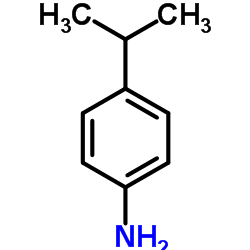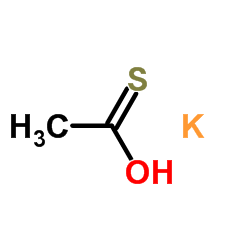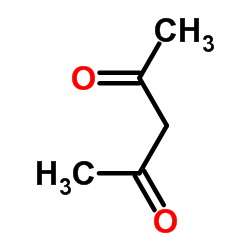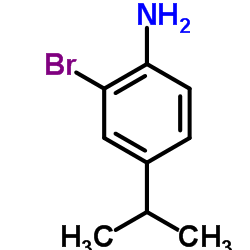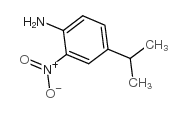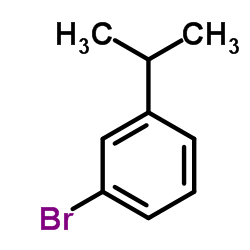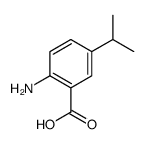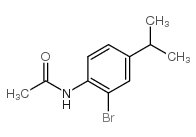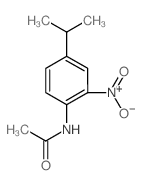5702-74-9
| Name | 4-isopropylacetanilide |
|---|---|
| Synonyms |
1-(acetylamino)-4-(1-methylethyl)benzene
4-acetaminoisopropylbenzene MFCD00026406 N1-(4-ISOPROPYLPHENYL)ACETAMIDE N-(4-ISOPROPYL-PHENYL)-ACETAMIDE p-isopropylacetanilide |
| Density | 1.026g/cm3 |
|---|---|
| Boiling Point | 323.7ºC at 760mmHg |
| Melting Point | 101ºC |
| Molecular Formula | C11H15NO |
| Molecular Weight | 177.24300 |
| Flash Point | 191.1ºC |
| Exact Mass | 177.11500 |
| PSA | 29.10000 |
| LogP | 2.84140 |
| Index of Refraction | 1.552 |
Synonym:4-Isopropylacetanilid Section 2 - COMPOSITION, INFORMATION ON INGREDIENTS
Risk Phrases: 22 Section 3 - HAZARDS IDENTIFICATION EMERGENCY OVERVIEW
Harmful if swallowed. Potential Health Effects Eye: May cause eye irritation. Skin: May cause skin irritation. May be harmful if absorbed through the skin. Ingestion: Harmful if swallowed. May cause irritation of the digestive tract. Inhalation: May cause respiratory tract irritation. May be harmful if inhaled. Chronic: Not available. Section 4 - FIRST AID MEASURES Eyes: Flush eyes with plenty of water for at least 15 minutes, occasionally lifting the upper and lower eyelids. Get medical aid. Skin: Get medical aid. Flush skin with plenty of water for at least 15 minutes while removing contaminated clothing and shoes. Ingestion: Get medical aid. Wash mouth out with water. Inhalation: Remove from exposure and move to fresh air immediately. If not breathing, give artificial respiration. If breathing is difficult, give oxygen. Get medical aid. Notes to Physician: Section 5 - FIRE FIGHTING MEASURES General Information: As in any fire, wear a self-contained breathing apparatus in pressure-demand, MSHA/NIOSH (approved or equivalent), and full protective gear. Extinguishing Media: Use water spray, dry chemical, carbon dioxide, or chemical foam. Section 6 - ACCIDENTAL RELEASE MEASURES General Information: Use proper personal protective equipment as indicated in Section 8. Spills/Leaks: Vacuum or sweep up material and place into a suitable disposal container. Section 7 - HANDLING and STORAGE Handling: Avoid breathing dust, vapor, mist, or gas. Avoid contact with skin and eyes. Storage: Store in a cool, dry place. Store in a tightly closed container. Section 8 - EXPOSURE CONTROLS, PERSONAL PROTECTION Engineering Controls: Use adequate ventilation to keep airborne concentrations low. Exposure Limits CAS# 5702-74-9: Personal Protective Equipment Eyes: Not available. Skin: Wear appropriate protective gloves to prevent skin exposure. Clothing: Wear appropriate protective clothing to prevent skin exposure. Respirators: Follow the OSHA respirator regulations found in 29 CFR 1910.134 or European Standard EN 149. Use a NIOSH/MSHA or European Standard EN 149 approved respirator if exposure limits are exceeded or if irritation or other symptoms are experienced. Section 9 - PHYSICAL AND CHEMICAL PROPERTIES Physical State: Solid Color: white Odor: Not available. pH: Not available. Vapor Pressure: Not available. Viscosity: Not available. Boiling Point: Not available. Freezing/Melting Point: 101 - 103 deg C Autoignition Temperature: Not available. Flash Point: Not available. Explosion Limits, lower: Not available. Explosion Limits, upper: Not available. Decomposition Temperature: Solubility in water: Specific Gravity/Density: Molecular Formula: C11H15NO Molecular Weight: 177 Section 10 - STABILITY AND REACTIVITY Chemical Stability: Not available. Conditions to Avoid: Incompatible materials. Incompatibilities with Other Materials: Acids, strong oxidizing agents, acid chlorides. Hazardous Decomposition Products: Nitrogen oxides, carbon monoxide, carbon dioxide. Hazardous Polymerization: Has not been reported Section 11 - TOXICOLOGICAL INFORMATION RTECS#: CAS# 5702-74-9 unlisted. LD50/LC50: Not available. Carcinogenicity: N1-(4-Isopropylphenyl)acetamide - Not listed by ACGIH, IARC, or NTP. Section 12 - ECOLOGICAL INFORMATION Section 13 - DISPOSAL CONSIDERATIONS Dispose of in a manner consistent with federal, state, and local regulations. Section 14 - TRANSPORT INFORMATION IATA No information available. IMO No information available. RID/ADR No information available. Section 15 - REGULATORY INFORMATION European/International Regulations European Labeling in Accordance with EC Directives Hazard Symbols: XN Risk Phrases: R 22 Harmful if swallowed. Safety Phrases: S 36/37 Wear suitable protective clothing and gloves. WGK (Water Danger/Protection) CAS# 5702-74-9: No information available. Canada None of the chemicals in this product are listed on the DSL/NDSL list. CAS# 5702-74-9 is not listed on Canada's Ingredient Disclosure List. US FEDERAL TSCA CAS# 5702-74-9 is not listed on the TSCA inventory. It is for research and development use only. SECTION 16 - ADDITIONAL INFORMATION N/A |
| Hazard Codes | Xn:Harmful; |
|---|---|
| Risk Phrases | R22 |
| Safety Phrases | 22-36/37/39 |
|
~93% 
5702-74-9 |
| Literature: Farhadi, Saeid; Panahandehjoo, Somayeh Applied Catalysis A: General, 2010 , vol. 382, # 2 p. 293 - 302 |
|
~% 
5702-74-9 |
| Literature: US6541470 B1, ; |
|
~88% 
5702-74-9 |
| Literature: THE TEXAS A and M UNIVERSITY SYSTEM Patent: WO2006/23763 A1, 2006 ; Location in patent: Page/Page column 12; 13 ; |
|
~77% 
5702-74-9 |
| Literature: Bhattacharya, Apurba; Suarez, Victor; Tamez Jr., Victoriano; Wu, Jiejun Tetrahedron Letters, 2006 , vol. 47, # 19 p. 3221 - 3223 |
|
~85% 
5702-74-9 |
| Literature: Sun, Xi; Wang, Min; Li, Pinhua; Zhang, Xiuli; Wang, Lei Green Chemistry, 2013 , vol. 15, # 12 p. 3289 - 3294 |
|
~% 
5702-74-9 |
| Literature: Heterocyclic Communications, , vol. 17, # 3-4 p. 111 - 119 |
|
~% 
5702-74-9 |
| Literature: Acta Chemica Scandinavica, Series B: Organic Chemistry and Biochemistry, , vol. 34, # 9 p. 693 - 694 |
| Precursor 7 | |
|---|---|
| DownStream 7 | |
